Day 5, the final day of our big 5 day Spring Bird Tour. It was a lovely day, with sunshine and blue skies, but a nagging easterly wind picked up during the morning.
Our first destination for the day was Burnham Overy Dunes. As we walked out across the grazing marshes we spotted a lone Whimbrel out on the grazing marshes, so we had a quick look at it through the scope. A little further along, and a second Whimbrel flew low overhead, then was we rounded the hedge we could see two more on the ground, this time much closer.
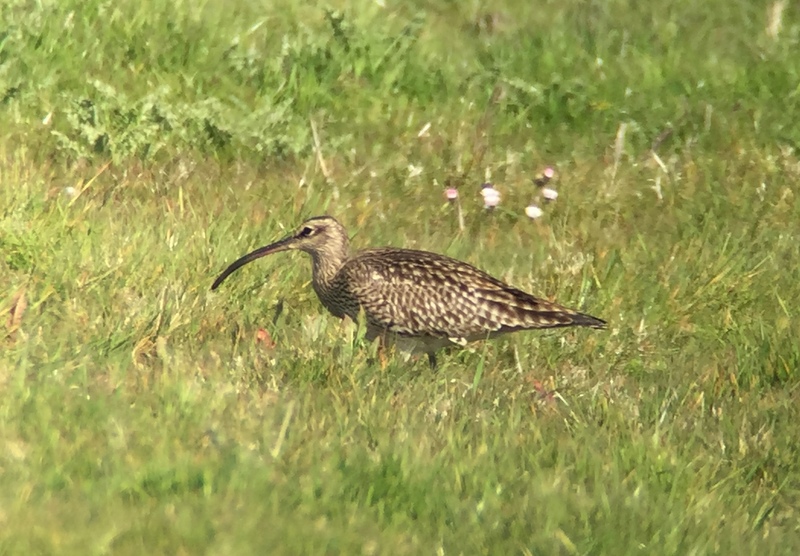 Whimbrel – we had a good look at two on the grazing marshes
Whimbrel – we had a good look at two on the grazing marshes
We got a great look at these last two, and could see their boldly marked heads. We talked a little about the identification of Whimbrel versus Curlew, the different body shape of the two being a good clue to identification, as well as the shorter bill of the Whimbrel. We could see the slim body and long wings of the two Whimbrel out on the grass.
There were other waders out on the grazing marshes too. Three Oystercatchers were asleep, possibly waiting for the tide to go out in the harbour. There were quite a few Lapwings and one or two Redshank. All three of these species breed here, unlike the Whimbrel which are just passage migrants. There were also a few ducks out on the pools, and lots of geese all over on the grass, Greylag Geese and Egyptian Geese predominating at this time of year.
The summer warblers are now here in force and singing, claiming their territory and trying to attract a mate. A Common Whitethroat sang from the top of the bushes by the gate and a Chiffchaff was flitting around in a sallow just beyond, helpfully breaking into song just after we had been looking at it. There are lots of Sedge Warblers all along the track here, singing from the brambles by the ditches. A resident Cetti’s Warbler shouted at us as we approached and we stood for a while to see if we could see it, and it duly zoomed past between bushes a couple of times.
 Sedge Warbler – several were singing from the bushes along the track
Sedge Warbler – several were singing from the bushes along the track
With the sun out, there were even a few butterflies out today, with both Peacock and Small Tortoiseshell finding some shelter, basking in the wheel ruts out of the wind. We also saw a couple of Small Coppers out in the dunes.
As we approached the seawall, we could head Mediterranean Gulls calling. We looked up to see a couple of them circling over the harbour beyond, their white wingtips flashing bright in the sunshine. While we were watching the Mediterranean Gulls, we noticed Stuart, former proprietor of The Bird ID Company, coming towards us, on his way back from an early morning in the dunes. He stopped for a quick chat about what he had seen.
When we got up onto the seawall, we could see it was high tide. All the mud was covered by water and small groups of waders were roosting around the edges or on little islands of vegetation. There was a nice flock of Black-tailed Godwits closer to us, some already in orange summer plumage, and a few Bar-tailed Godwits and Grey Plover further back. Some of the Grey Plover were already showing quite a bit of black on their bellies.
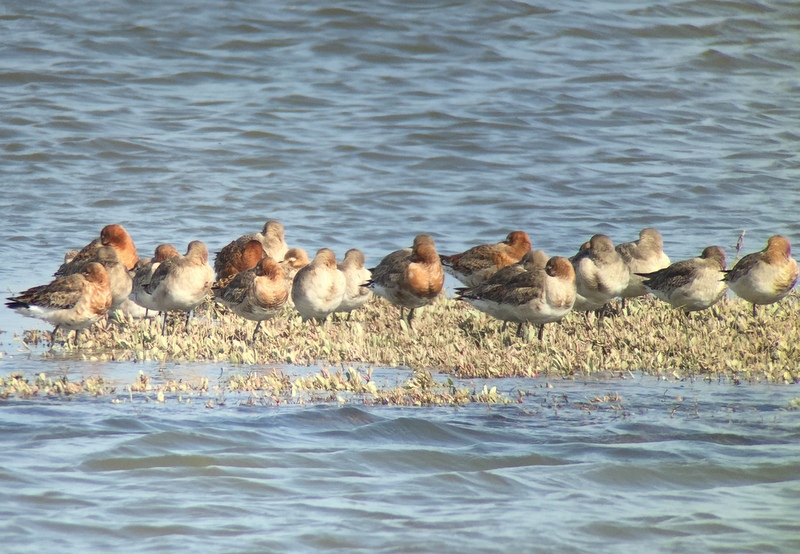
Even though they were asleep, with their heads tucked in, and mostly face on to us, we could see the differences in colour and pattern of the underparts between the summer plumage Black-tailed Godwits and Bar-tailed Godwits. A small flock of Knot flew past, with some of them too in orange summer plumage. A few Brent Geese were still lingering in the harbour – they should soon be on their way to Russia for the breeding season.
The dunes here are always full of Linnets and Meadow Pipits and there were quite a few already around the boardwalk bushes, along with a couple of Reed Buntings too. We turned west and headed out towards Gun Hill. On the way, we came across several Wheatears feeding on the short grass, which flew ahead of us flashing their white rumps. A lone Willow Warbler was in bushes, presumably a migrant on its way up to Scandinavia.
There had been a Whinchat here earlier, so we wade a circuit of all the bushes looking for it. While we were walking along a narrow path between clumps of brambles, a female Common Redstart flew down into the path in front of us. It got a bit of a shock when it saw us and darted straight back into a small sycamore, flashing its orange red tail as it went. Unfortunately it was all too quick and impossible for most of the group to get onto on such a narrow path. While they stood and watched from a suitable vantage point, one of us circled round the back and tried to see if the Redstart might fly out again, but it had completely disappeared. Despite looking all round the area, we unfortunately couldn’t relocate it, nor could we find the Whinchat.
From the dunes, we could see several Little Terns feeding out over the harbour. We decided to walk round on the beach to see if any were resting on the stones, but we couldn’t get round the tern fence, which extended right out into the water, not where it is normally put. We did stop and scan the beach from here and found a nice selection of waders roosting out on the point over the high tide. There was a nice flock of Bar-tailed Godwits feeding along the high tide line, including one colour-ringed bird. Subsequent contact with the ringing scheme has revealed it was ringed at Banc d’Arguin in Mauritania in January!
There was also a single Ringed Plover and a smart summer plumage Turnstone with white face and rusty shoulders. A lone Common Sandpiper fed up and down the tide line before flying off across the harbour. A White Wagtail feeding on the beach with all the waders had presumably stopped off to rest on its journey along the coast, a welcome bonus.
 Common Sandpiper – feeding on the beach at Gun Hill at high tide
Common Sandpiper – feeding on the beach at Gun Hill at high tide
We had to walk back past Gun Hill to get out onto the beach the other side of the point. A large flock of Sanderling was just in the process of being chased off by a couple of people walking along the sand. There were several more Ringed Plover on the beach behind the tern fence, but further along it had been washed away by the tide and more people were walking through the area where the Little Terns should be settling. We notified the wardens and it should be repaired, but it did mean there were no Little Terns on the beach today.
While we were scanning the beach, we spotted three larger terns flying across the harbour the other side of the point, some distance away from us. They disappeared out of sight behind the dunes but a few seconds later reappeared over our heads. They flew straight out across the beach and turned east over the sea. They were Arctic Terns on their migration north, and it turned out there was a huge passage of them today, as we were also to see later. It was remarkable to think that they were on their way north to the arctic having just come from spending our winter around the antarctic ocean!
As we walked back up into dunes, we heard the shrill call of a Yellow Wagtail and looked up to see it flying west overhead. Another migrant on its way, it did not stop but as it came low past us it was the first we were able to get onto properly, and we could see a flash of bright yellow underparts.
We made our way back to the boardwalk and continued on past it, east through the dunes. The wind was picking up now, but in a sheltered spot out of the breeze, we found several more Wheatears feeding. As we were walking past them, we heard a loud chacking call and a Ring Ouzel flew out of a bush and disappeared over the dunes in front of us. We could hear it again round the other side, calling from some more bushes, and as we walked towards the sound it flew again. This time it landed briefly on the top of a dune where we could get a look at it. It was a female, with a poorly marked, dull gorget. It then flew off strongly west over the dunes and disappeared from sight.
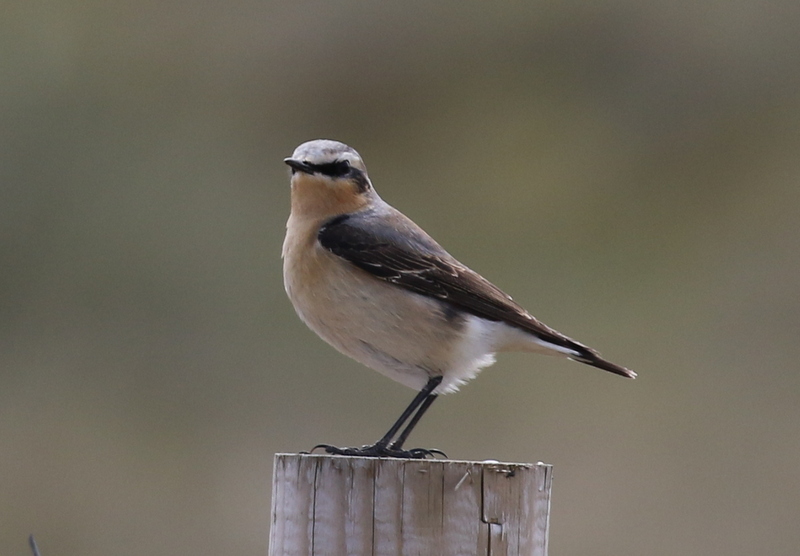 Wheatear – there were several in the dunes today
Wheatear – there were several in the dunes today
There were plenty of Stonechats in the dunes today – they breed here and we saw males singing and a few females and pairs too. But there was no sign of the hoped for Whinchat on our walk towards the pines. As we approached the west end of the trees, we could hear a Woodlark singing, although we had been expecting it as it had been reported here earlier.
The Woodlark was distant at first, a spot hovering over the dunes, but we got closer and eventually we had it hovering right over ours heads, singing its slightly melancholy sounding song. We also got a great look at its distinctive flight profile – broad rounded wings and short tail. It was getting rather windy now and the bushes south of the fence were being blown around, so we couldn’t see any activity around them from where we were.
 Woodlark – hovered right over our heads, singing, in the dunes
Woodlark – hovered right over our heads, singing, in the dunes
As we turned to start making our way back, a Ring Ouzel flew past, this time a smart male with bright white gorget. It flew past the bushes and then turned and flew up into the dunes at the end of the pines. Looking away in the other direction, we could see a Spoonbill distantly flying out towards the harbour.
Scanning the bushes as we went back, we finally found a Whinchat. It was perched on top of a small hawthorn bush in the dunes south of the fence. We got the scope on it, but it flew off before everyone could get a look at it. Perhaps because of the wind, it was feeding on the ground today with the Wheatears, and it kept getting itself tucked down in little sheltered hollows in the dunes where we couldn’t see it. Once everyone had enjoyed OK views of the Whinchat, we carried on back to the boardwalk.
There were now lots of reports from elsewhere along the coast of Arctic Terns and Black Terns passing offshore, so we walked up to the top of a dune to scan the sea. We managed to see another Arctic Tern flying east just offshore, but it was very windy and exposed up here, so we didn’t stay long. As we walked back along the seawall, a Red Kite flew over the grazing marshes nearby, mobbed by a couple of Lapwings.
To get out of the wind, we made our way back to Holkham for lunch. Lady Anne’s Drive was predictably very busy, it being a bank holiday weekend, but we were surprised how many cars were up at the hall. Eventually we found somewhere where we could park and ate our lunch down on the grass, watching a pair of Mistle Thrushes flying back and forth in and out of the trees with food for their young.
With all the terns on the move today, we thought it would be nice to have a look at them from somewhere a bit more sheltered, so we made our way along to Cley after lunch. There were still some Arctic Terns moving, but unfortunately it appeared we had missed the bulk of the Black Terns already. In about half an hour, we saw over 40 Arctic Terns fly past, including one flock of around 20, plus a few Common Terns, a Little Tern, a Fulmar, 2-3 Gannets, and a single Great Skua which landed on the sea. A Grey Seal was lurking just offshore. Not a bad return for our efforts!
There had been a Wryneck reported earlier from Walsey Hills, but they can be elusive at the best of times. When it was seen again, we thought it might be worth a look, with suitable warnings that it might be difficult to see. When we arrived on the steps where it had been reported, there were several people standing around and no one seemed to know when it had last been seen. We hadn’t been there five minutes when someone announced ‘there it is’ and the Wryneck hopped out into view!
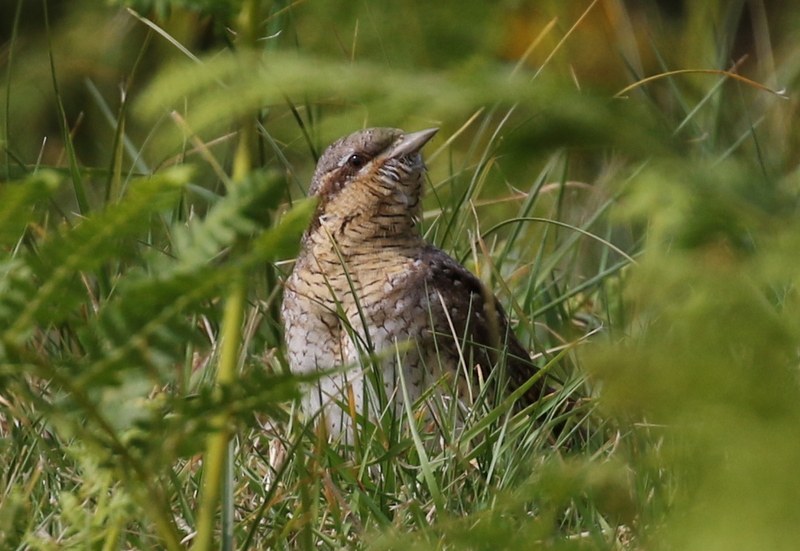 Wryneck – showed very well after just five minutes wait!
Wryneck – showed very well after just five minutes wait!
The Wryneck was quite tricky to get onto at first, feeding on the ground in among the young bracken shoots on the bank. They are also very well camouflaged, with their cryptic plumage, but it quickly hopped out into a clearer patch where we could all get a really good look at it. Wrynecks are a very scarce migrant passing through here these days, so smiles all round – it was a great bird to see!
While we were watching the Wryneck, we learned that there had been five Black Terns out on Arnold’s Marsh. Unfortunately, although they had apparently been there for some time, no one seemed to have told anyone before they flew off! We went for a quick walk up along the East Bank anyway. As we suspected, there were just Sandwich Terns present now, which were still nice to see properly. There were also good numbers of Bar-tailed Godwits, Grey Plover and Dunlin, with several now in smart summer plumage.
 Sandwich Terns – roosting on Arnolds Marsh in the wind
Sandwich Terns – roosting on Arnolds Marsh in the wind
With the blustery wind, we didn’t hang around out here today, but made our way back to the car. Back at Walsey Hills, two Little Grebes were calling, like madmen laughing, and we saw them swim across and disappear into the reeds.
Stiffkey Fen was our last destination for the day. On the walk out, a couple of Blackcaps were singing from the bushes and a few Swallows and House Martins were hawking for insects over the trees. There were lots of gulls out on the Fen, but all we could find here today were Black-headed Gulls. A flock of Black-tailed Godwits were mostly asleep in the water down at the front. There were a few ducks, including a single Common Pochard and a couple of late Wigeon.
With the tide out, we were hoping to find some waders in the channel, but there was nothing visible upstream and just a couple of Avocets, a Redshank and a Black-tailed Godwit opposite the Fen. We walked along to the end of the seawall, but there were several people crossing the water out on the near edge of the harbour with a couple of dogs, so no birds there. The only thing we could see of note from here were three smart summer Common Gulls resting on the mud in the channel.
As we turned to walk back, a Grey Heron flew up out of the reeds on the Fen and landed next to a Little Egret on the edge of the water. It was funny to see them side by side, little and large.
This is normally a good spot for Greenshank, a species we had not yet caught up with on our five days, so we were disappointed not to see one, although they can get out in the smaller muddy channels in the harbour at low tide. We were almost back to the steps when we took a last look up the channel next to the seawall and noticed three waders come round the corner from further up. Through the scope we confirmed they were Greenshank – just in the nick of time!
 Greenshank – 2 of the 3 at Stiffkey Fen today
Greenshank – 2 of the 3 at Stiffkey Fen today
There is the occasional Greenshank which spends the whole winter here, but these are presumably migrants, stopping off on their way back north. They are in summer plumage now, with extensive black spotting down their breasts.
Suddenly the Greenshank took off and flew past us round onto the Fen. Then everything took off, whirling round before landing again – something was clearly spooking all the birds. It was a minute or so later that a juvenile Peregrine finally flew in over the Harbour!
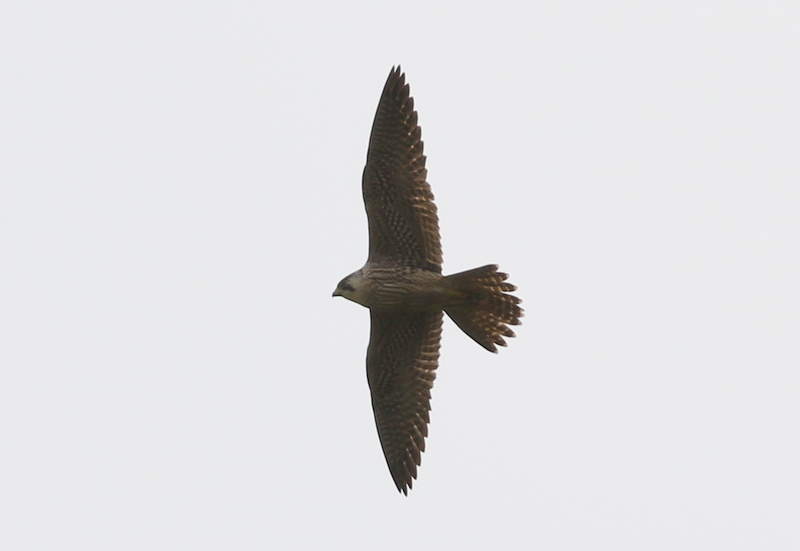 Peregrine – this juvenile flew in from the Harbour
Peregrine – this juvenile flew in from the Harbour
The Peregrine circled over the edge of the Fen for a minute or so, giving us a great view, before flying high across the water and disappearing away over the fields beyond. Having been spooked earlier, all the birds on the Fen were completely disinterested when it finally made its flyby.
It was a great way to end the day, and to round off a very exciting five days of spring birding in Norfolk. The weather had been somewhat mixed this week, but despite its best efforts we had seen a remarkable number of different birds. A very successful tour!
















